System for simulating cerebrospinal injury
a cerebrospinal injury and system technology, applied in the field of apparatus and process for simulating human central nervous system injuries, can solve the problems of difficult development of prevention and/or interventional methodologies to limit the extent of injury, lack of clinical trials efficacy, and high cost of severe tbi to the individual and family, and achieve the effect of facilitating calculation of axonic injury
- Summary
- Abstract
- Description
- Claims
- Application Information
AI Technical Summary
Benefits of technology
Problems solved by technology
Method used
Image
Examples
Embodiment Construction
[0030] The subject invention has utility as a model that closely resembles human DAI in order to develop protective measures for subjects.
[0031] The system of the present invention is utilized in testing processes including automobile crash analysis and other moving vehicle or device analysis including bicycles, boats, airplanes etc. The system of the present invention also has utility in the testing process for the effects of sustained high acceleration space travel, long duration hypersonic commercial jet travel, and other movement of the human body where the possibility of sudden or sustained deformative forces which can result in brain or spinal cord injuries are at play. By obtaining this data, the forces applied to an inventive simulated head can be compared with normative values and appropriate compensatory techniques can be devised in order to prevent future injury.
[0032] Referring to FIG. 1, a system for modeling traumatic brain and spinal cord injury is generally shown a...
PUM
 Login to View More
Login to View More Abstract
Description
Claims
Application Information
 Login to View More
Login to View More - R&D
- Intellectual Property
- Life Sciences
- Materials
- Tech Scout
- Unparalleled Data Quality
- Higher Quality Content
- 60% Fewer Hallucinations
Browse by: Latest US Patents, China's latest patents, Technical Efficacy Thesaurus, Application Domain, Technology Topic, Popular Technical Reports.
© 2025 PatSnap. All rights reserved.Legal|Privacy policy|Modern Slavery Act Transparency Statement|Sitemap|About US| Contact US: help@patsnap.com

